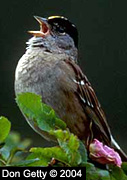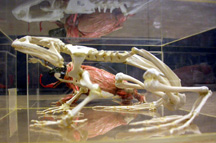Other Collections
Sound Collection

The MVZ houses approximately 6,000 sound recordings, ranking it one of the largest collections in the United States. The majority of recordings are of passerine birds, but the Sound Collection also contains recordings of owls and hummingbirds as well as some non-avian taxa, such as amphibians. MVZ ornithologists routinely record vocalizations in the field, and many of these are catalogued with the voucher specimens. All recordings are digitally available through the MVZ Arctos database. The MVZ Sound Collection has been used in systematic and behavioral studies as well as for identification guides. For example: listen to the male Spotted Towhee song, which differ geographically in the western United States.
Contact the staff curator for the Bird Collection for recordings to play along with sonograms.
Chromosomes and Karyotypes

The MVZ houses a collection of chromosome spreads on slides, photographs, negatives, and cell suspensions for approximately 7,000 mammal specimens. In addition, tooth sections are available for ca. 100 specimens (primarily marine mammals). The karyology collection was built primarily by Dr. James Patton and his lab over the last three decades.
Contact the staff curator of Mammal Collection, if interested.
Histology
The MVZ is home to an outstanding collection of histological sections for light microscopy, many from species that are difficult if not impossible to obtain today. Especially valuable and unique is a collection of complete, serially sectioned heads of caecilians, salamanders, and frogs that have valuable anatomical uses, e.g., in studies of the skeleton, tongue, or brain. Stained, paraffin sections from over 150 species of amphibian are housed in 300 or more standard slide boxes.
Contact the staff curator of Amphibian and Reptile Collections, if interested.
Hildebrand Anatomical Collection

This collection of unusual specimen preparations, including freeze-dried displays of muscles, feet, tongues, and other anatomical parts, was created by Milton Hildebrand, Professor Emeritus, University of California at Davis, and a former MVZ graduate student. Hildebrand developed and perfected most of the anatomical techniques used in his specimen preparations, and many items in the collection are cross-referenced to laboratory exercises in vertebrate functional morphology courses that he designed. These unique and often delicate anatomical preparations makes them especially valuable for teaching, but also prohibits their availability for loans.
Direct any inquiries to any staff curator.
Hildebrand Film Collection
A separate component of the Hildebrand collection is series of short, 16-mm films that illustrate locomotor modes for many mammals. Limited footage is devoted to other terrestrial vertebrates. These films were made in conjunction with Hildebrand’s research on vertebrate locomotion and gait analysis.
Direct any inquiries to the MVZ Archives
Grinnell-Miller Library (journals, books, reprints, etc.)
The MVZ maintains a small collection of ca. 2000 books, journals, and theses on topics such as organismal biology, evolution, ecology, distribution, taxonomy, and conservation. The library is used primarily by researchers and curators in the MVZ. We also maintain separate limited reprint libraries for herps, birds, and mammals.
Direct any inquiries to the MVZ Archives.
